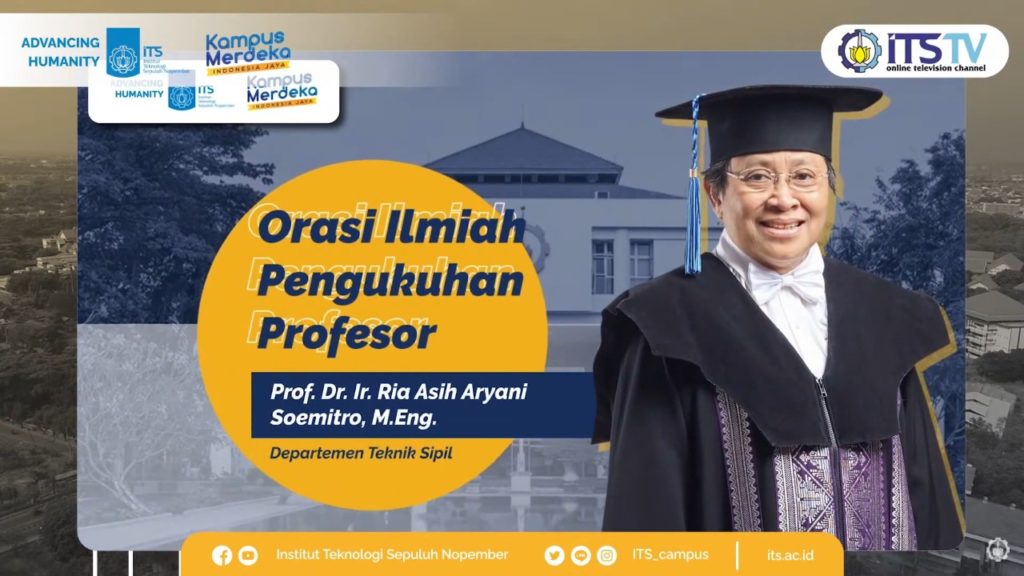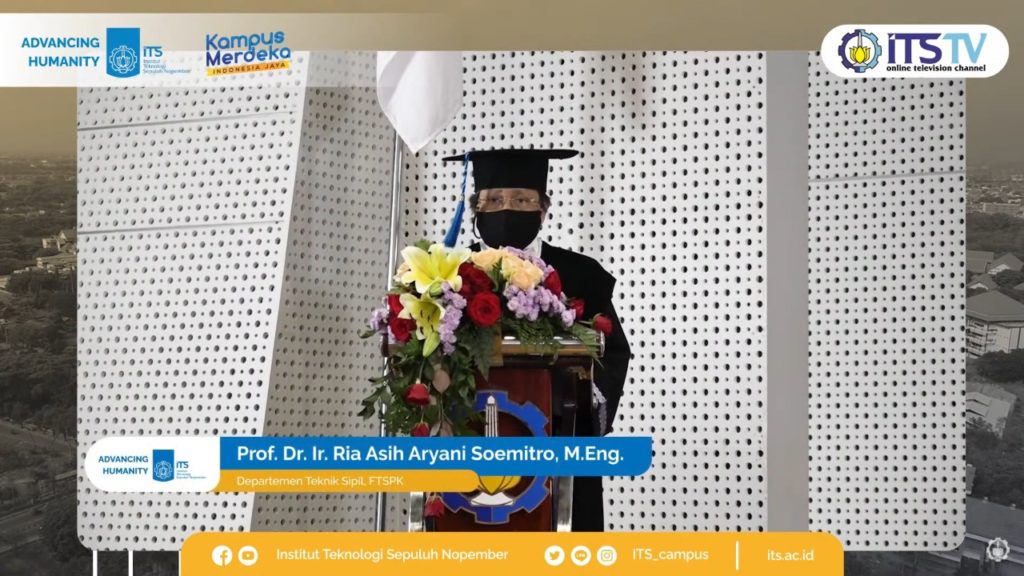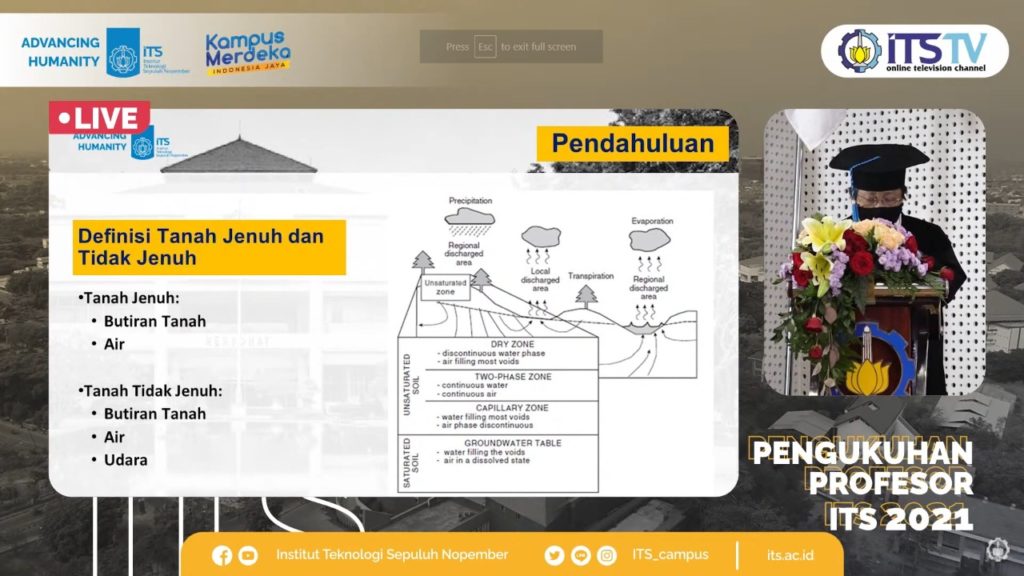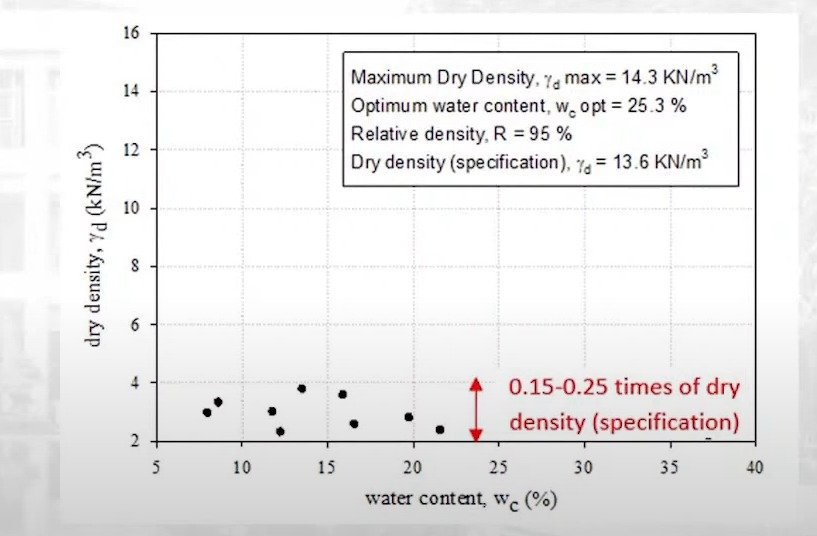ITS Professor Utilizes Unsaturated Soil Principles for Infrastructure

Prof. Dr. Ir Ria Asih Aryani Soemitro MEng from the Department of Civil Engineering who was inaugurated as ITS Professor on March 31, 2021
ITS Campus, ITS News – The characteristics of the land that are not always constant make the stability of the infrastructure also change. Based on that, one of the professors of the Institut Teknologi Sepuluh Nopember (ITS). Prof. Dr. Ir. Ria Asih Aryani Soemitro MEng analyzed and applied the principle of unsaturated soil to maintain infrastructure stability.
He explained the research in his inaugural scientific oration as ITS professors on March 31. The Professor of Geotechnical Engineering explained the changes in infrastructure stability and took a topic related to embankment infrastructure.
This lecturer at the Department of Civil Engineering explained that the stability of the embankment will be maintained If the soil compiling is by the initial plan. “However, this condition will be difficult to achieve because the characteristics of the soil always change along with changes in the cycle of the rainy season and the dry season,” he said.

Prof. Dr. Ir Ria Asih Aryani Soemitro MEng when delivering a scientific oration in his inauguration as ITS Professors
Meanwhile, the 65-year-old professor also gave an explanation of unsaturated soil, where unsaturated soil has three phases, namely solid soil, air, and water. However, unsaturated soil will be better if there is a fourth phase, namely the air-water interaction phase or contractile skin, which acts as an elastic membrane to influence the mechanical behavior of the soil.
Furthermore, Ria said that changes in soil characteristics have a domino effect in the form of embankment sliding. The Change in river water level also causes the possibility of an embankment landslide to be even greater. “Most of the embankment avalanches in Indonesia indicated as a result of changes in groundwater level fluctuations during the rainy and dry seasons which can vary up to 10 meters,” he explained.

The initial explanation regarding the characteristics of unsaturated soil, which has four phases delivered by Prof. Dr. Ir Ria Asih Aryani Soemitro Meng
Ria continued by showing a graph of the difference in field dry-density when the embankment built with the dry density of the field after five years of development. Field dry density itself is the dry weight per unit content or soil density itself. From the results obtained, the woman born on January 19, 1956, stated that the dry density of the field remains only 15 percent to 25 percent of the initial dry density in five years.
This phenomenon indicates the influence of the rainy and dry seasons on the physical characteristics of the soil through the wetting and drying cycles. In this case, happens reduction characteristics drastic happens between the first and second cycles. “Changes in soil characteristics have started since the date it was built so that changes in the stability of the embankment should be taken into account indirectly,” he said.

Comparison between the dry density of the dike field at the start of construction over five years
Finding problems and possible landslide hazards, Ria concluded that changes in soil characteristics needed to be reviewed to determine the safety number for the stability of the embankment. This is because the physical and mechanical changes of the soil have not been widely discussed by previous researchers. “From the sensitivity analysis of soil parameters that are very influential for safety figures is cohesion, while soil volume weight does not affect,” explained the alumnus of Nanyang Technological University (NTU), Singapore.
Ria conveyed that the process of changing the cross-section of the river began with the interaction between the soil materials that compose the river cross-section and the river flow could potentially result in riverbank sliding. The existence of this riverbank sliding resulted in a change in the cross-section of the river. Thus, erosion occurs at a flow rate of 0.3 to 1 meter per second and material will begin to be transported at a flow rate of between 0.01 to 0.3 meters per second.
Taking into account the factors and conditions in the field, this Principal Investigator at the MIT Indonesia Research Alliance (MIRA) found that the cumulative erosion rate for predicting river bank erosion was 1.3 meters or about 6 percent below field measurements. “So we can see that the Erodibility-coefficient value based on field research for prediction of river channel displacement is important,” explained Ria.
Ending the presentation delivered, Ria gave an understanding that the Erodibility-coefficient is an important factor. Changes in soil characteristics that occur along with changes in this season can be a guide or a guide to determine the behavior of changes in soil characteristics in Indonesia. “For its application, changes in these characteristics will be very useful in determining the safety number of embankment stability,” concluded the author of the book Characteristics of Unsaturated Soil. (pan/ITS Public Relations)
Reporter: Yanwa Evia Java
Related News
-
Supporting the Development of Material Processes, ITS Professors Utilize Biomass Waste
ITS Campus, ITS News — Innovation in material processes continues to develop to support society’s need for environmentally friendly
April 19, 2021 15:04 -
ITS Professor Ideas for Bio-Corrosion Control in Marine Structures
ITS Campus, ITS News — Coastal and offshore buildings interacting directly with seawater trigger damage, including bio-corrosion. If not
April 19, 2021 15:04 -
ITS Launches the First Marine Floating Solar Power Plant Prototype in Indonesia
ITS Campus, ITS News — Institut Teknologi Sepuluh Nopember (ITS)‘s commitment in realizing the energy transition is getting serious.
April 19, 2021 15:04 -
Targeting Champion, Bayucaraka ITS Launches Flying Robot Innovation
ITS Campus, ITS News – The Bayucaraka team at Institut Teknologi Sepuluh Nopember (ITS) has launched four new flying
April 19, 2021 15:04
